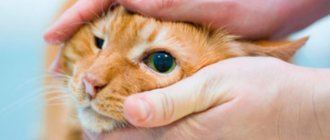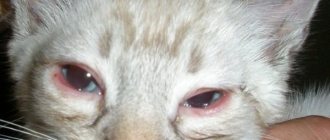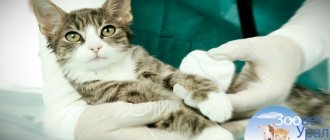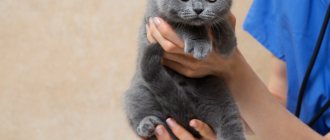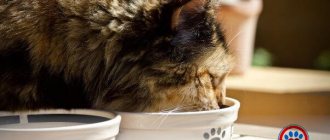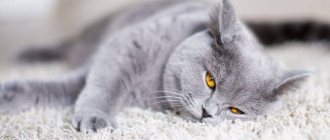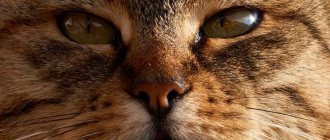If the Sphynx's eyes fester, this may be a symptom of conjunctivitis, blepharitis, or entropion. In addition to suppuration, the inflammatory process is accompanied by photophobia, unnatural squinting of the eye, and swelling. At the first symptoms, you should take your pet to a veterinarian, who will prescribe medications or perform surgery.
Veterinarians warn that purulent eye diseases in most cases lead to panophthalmitis, so treatment of inflammation should begin quickly.
How and why does suppuration develop in sphinxes?
Inflammation of the connective membrane
The eyeball of the sphinx is covered by the conjunctiva, a tissue that produces tear and mucous fluid to moisturize the eye. Hairless cats have almost no eyelashes, so their visual organs are not sufficiently protected. Damage to the membrane promotes the introduction of pathogenic microflora into the eye structures, which provokes an inflammatory process. Causes:
- fights with relatives;
- incorrectly performed or lack of eye toilet;
- use of contaminated hygiene products;
- allergies, in which the animal scratches its eyes and causes microtrauma;
- entry of a foreign body into the visual organ.
Conjunctivitis is accompanied by the following symptoms:
- profuse lacrimation;
- eye hyperemia;
- swelling;
- soreness;
- the appearance of purulent discharge;
- the formation of crusts, due to which the eyelids stick together.
Blepharitis (inflammation of the eyelids)
A visual decrease in the palpebral fissure and the appearance of purulent crusts may be signs of the development of blepharitis.
It is characterized by a violation of the integrity of the ocular skin folds, through which pyogenic microorganisms - staphylococci or streptococci, as well as fungi - penetrate. Often the disease is accompanied by severe itching, which causes the Sphynx to scratch the eye and contribute to the spread of infection. The disease can be acute or chronic. Causes:
- injuries;
- skin rashes due to helminths;
- eczema due to improper bathing and skin care regimen;
- violation of metabolic processes;
- lack of vitamins and microelements.
Blepharitis is accompanied by the following symptoms:
- edema;
- severe itching;
- redness;
- compaction and thickening of the eyelids;
- visual reduction of the palpebral fissure;
- the appearance of purulent crusts.
Turn of the century
If the sphinx's eye ligaments are weakened, the eyelid turns inward, creating friction against the cornea and injuring it. Entropion can be congenital, when the disease manifests itself in a kitten, or acquired, occurring due to injury or inflammatory processes. It is distinguished by its serious severity, since representatives of the breed have deep-set eyeballs. Signs:
In the case of an inversion of the eyelid, the pet experiences lacrimation and swelling of the organs of vision.
- painful reaction to light;
- lacrimation;
- local increase in temperature;
- swelling;
- squinting or blepharospasm;
- mucous discharge, which later becomes purulent;
- strong pain.
Panophthalmitis
The disease occurs in advanced cases when the infection spreads to all tissues of the eye and melts them. The main reason is late contact with the veterinarian and the owner’s attempt to cure the pet’s purulent process on his own. Symptoms:
- protrusion of the eyeball (exophthalmos);
- profuse suppuration;
- loss of vision;
- clouding of all transparent structures;
- puffiness and swelling of the eyelids.
Allergy to animals
Have you or your child ever experienced red spots or blisters on your skin if a cat licked you, or symptoms of conjunctivitis if you petted a cat and then rubbed the same hand over your eye? Most likely, you have sensitivity (from the Latin sensibilis sensitive) to cat allergens.
Sensitization to pets most often manifests itself as symptoms of respiratory, and less commonly, skin allergies. Signs of respiratory allergies manifest themselves in the form of symptoms from the nose (stuffiness, sneezing, mucous discharge), eyes (itching, redness, lacrimation) and lower respiratory tract (dry cough, wheezing in the chest, shortness of breath, suffocation); and skin – in the form of itching, redness of the skin.
Allergy symptoms
in pets vary in severity, ranging from mild discomfort associated with rhinitis and conjunctivitis, to life-threatening attacks of bronchial asthma.
Mammals kept as pets are an important source of allergies, and sensitization to animal dander of various species appears to be increasing worldwide. Pet allergens are mainly present in their fur, saliva and urine and are released into the external environment when they shed or shed dander.
Among pet allergens, cat allergens are the most potent. Cats are the cause of allergic diseases more often than dogs and other pets. The most important cat allergen, Fel d1, found in saliva and sebaceous glands, is present in cats of all breeds. Unneutered cats have more of it than females. Particles of desquamated cat epithelium up to 2.5 microns in size can remain in indoor air for a long time and penetrate into the lungs, causing exacerbation of allergic rhinitis in sensitive individuals, months after the animal is removed from the home. Animal allergens, when they get on clothing, can be carried into rooms and public places where there are no animals themselves, and provoke exacerbations of allergic rhinitis and asthma in people sensitive to them.
Allergy to dogs
Less common than cat sensitivity. The main allergen, Can f1, with which it is associated, is found in the saliva and fur of any dog, but its amount depends on the breed.
Sensitization to cat and dog allergens is a risk factor for the development of bronchial asthma and rhinitis. This was shown in a study in which sensitization to key allergenic components of pets was observed in young children before the development of respiratory symptoms.
Sensitivity to allergens from other animals that are often kept in the family - gerbil mice, guinea pigs, rabbits, ferrets - is rare. Allergies to farm animals - horses, cattle, pigs - are also observed.
Bird feathers in pillows, feather beds, and down clothes also have significant allergenic activity. Allergies can also be caused by pigeons, parrots, and canaries kept in apartments. In addition to bronchial asthma, poultry can cause the development of allergic rhinitis and exogenous allergic alveolitis.
Representatives of lower crustaceans and various species of daphnia in dry food for aquarium fish also have pronounced allergenic activity. Cases of allergic rhinitis and bronchial asthma have been described among members of families keeping aquariums and using dry food from daphnia.
Allergy prevention measures
The best way to avoid the effects of animal allergens is to remove a cat, dog, or other animal from the home. After an animal is removed from the apartment, several months pass before the concentration of allergens drops below the threshold. If the family does not want or cannot part with the pet, then it should be placed outside the living quarters, or, if this is not possible, do not allow the animal into the bedroom, use a highly efficient air filter, change the covers on mattresses and pillows, although these measures also allow sufficiently reduce the amount of allergens.
An allergist-immunologist can help you understand all the issues related to the causes of complaints of sneezing, itching and redness of the eyes, cough, difficulty breathing or itchy skin, select drug therapy if necessary and prescribe a set of treatment and preventive measures. The specialist will give all the necessary recommendations to relieve you and your child from the unpleasant manifestations of allergies. You can make an appointment with an allergist-immunologist by calling the clinic’s contact center.
Information prepared for you by:
Source
How to treat a sphinx?
Drug therapy
Do not use tea bags for compresses. They are not sterile, their effectiveness is questionable and may worsen the condition.
If a disease is detected, you should contact a veterinarian, who, after examination, will prescribe treatment, for example, Beafar Ophtal.
All medications are prescribed by a veterinarian; self-medication leads to organ loss. If the Sphinx's eyes are watery, but there is no inflammation, a thorough toilet should be carried out daily using hygienic means, such as:
- "Dewdrop";
- "Green tea";
- "Beafar Ophthal";
- "Klin Ai";
- "Kleenie";
- "Teddy Pets" (wet wipes for eyes).
Veterinarians recommend treating purulent diseases with the following antibacterial drops:
- "Leopard";
- "Iris";
- "Diamond Eyes";
- "Tsiprolet";
- "Anandin";
- "Zoohealth."
Herbal compresses
If the sphinx's organ of vision becomes sour, it is recommended to make lotions to soak and remove the crusts. Suitable herbal decoctions include chamomile, string, St. John's wort, and sage. Preparation:
- Take 3-5 g of any herb and pour 200 ml of hot water.
- Leave for 20-30 minutes, cool.
- Filter so that no debris or sediment remains.
- Moisten a cotton pad, squeeze it a little and gently apply it to the eye. Rubbing or squeezing the organ is prohibited.
- Carry out the procedure until the crust is completely removed.
Diagnosis of eye diseases in cats
Diagnosis of eye diseases in sphinxes is based on the methods of conventional superficial examinations and the use of instrumental methods. In the first case, the veterinarian observes external symptoms, the intensity of discharge and the affected area. The second group is more diverse and objective:
Inflammation and infections, general diseases and patency of the nasolacrimal ducts are determined using a special test. A small amount of contrast liquid is injected into the sphinx's eye, and after a few minutes its exit in the area of the mouth and nose is checked.
If there is a speck
If the cat is bothered by some speck that causes the eyes to fester, then you first need to rinse it, and if it doesn’t come out, it is removed by rinsing it towards the nearest corner, using a cotton swab liberally soaked in an antibacterial solution. . After any manipulation, a “pea” of tetracycline ointment is placed under the upper eyelid or a special medicine is instilled.
If kittens' eyes fester, what should you do? You must always be careful with your eyes, otherwise there is a possibility of aggravating an already unpleasant situation.
For purulent or phlegmonous conjunctivitis
In the presence of purulent or phlegmonous conjunctivitis, general and local therapy is used. The course of therapy includes periodic washing of the eyeballs with boric acid, followed by their subsequent treatment with syntomycin ointment or any other emulsion with an antibiotic. In this case, novocaine blockade with an antibiotic is also used. In addition to the pronounced, freezing effect, such a procedure will be useful in general therapeutic terms. In addition, antibiotics can be administered intramuscularly. In addition, your veterinarian may recommend sulfonamides for internal use.
What else needs to be done when a kitten’s eyes are very purulent?
Treatment of a pet at home
In most cases, treatment involves washing the affected eyes, instilling drops into them and placing ointments under the eyelids. You can do this at home. In this case, you must strictly follow the doctor’s recommendations regarding the dosage and duration of use of medications. Ignoring the veterinarian's prescriptions is fraught with serious complications.
What and how to wash your eyes to clear them of pus?
If your pet's eyes are festered, you need to rinse them before instilling drops or applying ointment. To remove pus, use chamomile decoction, boric acid (1 tsp per 50 ml of boiled water), 0.02 percent furatsilin. When washing you need:
Medicines in the form of drops
If a kitten or an adult pet has one or both eyes festered, he is prescribed eye drops. The following are used to treat animals:
To instill the drug, you need:
Symptoms of festering eyes
It is difficult not to notice the suppuration that forms on the pet’s face. The appearance of a cloudy, viscous fluid coming from the eyes is the main symptom. Pus does not always appear in large quantities. Sometimes it dries out, forming grayish crusts that stick to the fur in the nose area. Cats, being clean creatures, will constantly try to remove these formations.
The pus may be whitish, yellow, green, or brown. But regardless of this, any discharge causes cats the same discomfort. Therefore, pay attention to your pet if he begins to blink or squint frequently. In addition to the discharge, you may notice redness of the eyes and the delicate skin around them.
Pay attention to the condition of your pet. Sick animals often try to hide in dark and quiet places. They lose appetite and interest in games. If your animal was active and cheerful, but suddenly became apathetic, then this is a clear reason to carefully examine it and seek help from a veterinarian.
If a visual inspection was not enough, pay attention to the smell in the cat’s eye area - pus has a very specific and unpleasant odor
Causes
Festering eyes are not an independent disease, but only a symptom, and veterinarians identify many causes.
One of the most common is ophthalmological pathologies:
Often kittens are born with pathologies of the organ of vision. The defects cause watery eyes and discharge of pus. So, the baby may lack a lacrimal punctum, the lower eyelid may turn inward, eyelashes may grow in several rows, etc. Other causes of suppuration include:
The eyes can fester in any animal, regardless of gender and age. Breeds such as Scottish, British, and Persian are especially susceptible to this pathology. This is explained by the anatomical features of the skull.
Is it true that there are no allergies to hairless cats?
The most persistent and harmful myth is that hairless cats are hypoallergenic. People believe they are allergic to cat hair, and adopting a hairless pet seems like a good solution. Unfortunately, most often the allergy is caused by a special protein that is found in the saliva, urine and skin secretions of cats.
The Sphynx's skin contains sebum, a protective skin lubricant. This brown substance may be an allergen. If a person is allergic to cat saliva or fur, then he will be able to live in an apartment with a naked pet. All you need to do is wash your hands thoroughly after touching the cat.
Hypoallergenic? what are you saying?

